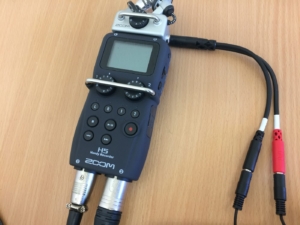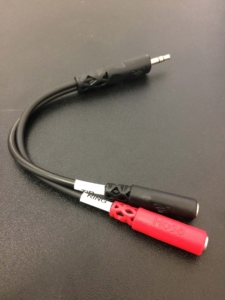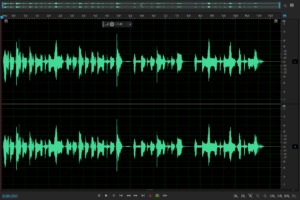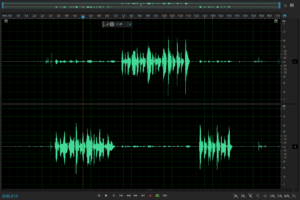What Is a Mic Splitter and Do I Need One?

A mic splitter cable (or audio splitter) is something you might use if you want to send the audio from one source to two or more places.
So what’s an example of this? Well, it might be that you and a friend are recording into a mic with only one headphone jack, but you’d both like to wear headphones. Plugging in a splitter will let you connect two pairs of headphones or earbuds.
Or, you might be recording into one device but you’d like to send the audio to a backup recorder too. A splitter can help you do that.
In this post, I’m going to focus on the latter. So let’s take a look at how and why a microphone splitter might help you record better sounding audio.

Using a Mic Splitter to Create “Two Channel” Recording
One of the most novel ways of using a mic splitter is if you have a small digital recorder, like the Tascam DR-05. Basically, a recorder that doesn’t have any XLR inputs to let you plug in multiple mics.
Sure, you can record multiple participants into the device’s built-in mics. But the sound levels are going to be inconsistent based on each person’s distance from the recorder, as well as how loud they talk.
An alternative is to run a splitter into your recorder’s 3.5mm input jack. Then, connect two mics into it. These would also be 3.5mm connecting mics – commonly, lavalier mics. The best “affordable quality” lavalier option out there right now, in my opinion, is the Rode Lavalier Go.
If you’re using a standard mic splitter for this, then the audio is going to be recorded in “joint stereo”. Here, you’ll still benefit from both participants being more “on-mic” (because they both now have their own mics). But if one is talking a lot louder than the other, that’s going to be hard to fix in the editing phase.
A solution for this is to use a mic splitter like the Hosa Stereo Breakout, which helps create something more akin to a “two-channel” or multitrack recording.
Heads Up: We’ve had some reports from users who’re having trouble getting this mic splitter to work with the Zoom H1. To see the ones we’ve checked it with, you’ll find a list of confirmed compatible recorders at the bottom of the post.
Splitting in Stereo
When I ran two lavalier mics into my digital recorder using a normal mic splitter, the audio was recorded in “joint stereo”. This means that both sides mirrored each other, as you can see in the first screenshot.
But if you’re using a stereo splitter like the Hosa Breakout model, you can clearly see the difference on both channels. There’s still a bit of “bleed” from one side to the next, but it’s minimal.
When you record in this manner, you can split the sides of your stereo track into two mono tracks in your editing software.
This means you can alter the levels of each participant independently if one person was a bit too loud or a bit too quiet.
Using Lav Mics Into a Digital Recorder
My first choice for using two lav mics simultaneously is to run them into the Zoom H5‘s XLR/TRS combo ports, using 3.5mm to 1/4″ mono adapters.
This gives you full control over both mics. You can set the gain of each independently, before and during the recording.
But if you’re using a smaller model of recorder that only has a 3.5mm port for external inputs, the Hosa Breakout gets you as close to two-channel recording as you’re likely to find with this type of setup.
Recording With Four Mics
If you’re using a recorder with two XLR/TRS combo ports, as well as a 3.5mm input (such as the Zoom H4 or Zoom H5), then you can use four microphones at the same time.

The two mics feeding into the combo ports will record on independent channels. At the same time, the Hosa Breakout will split its mics into a stereo track.
These can be separated into two mono tracks in post-production. All tracks can then be processed independently in your editing software.
This setup is like having a mobile radio studio with you at all times. It’s a fantastic option for ’roundtable’ recordings of four people.
Of course, a simpler way of doing things these days might be to opt for a dedicated multitrack podcast recorder like the Zoom PodTrak P4. This lets you record local participants, phone calls, online interviews, and play music/SFX during your sessions, too. Check out our full review of the Zoom PodTrak P4 and see what you think.
Summary: Using a Mic Splitter Cable
Mic splitters are a great way to add more flexibility to small and simple recording setups. At around $5, adding the Hosa Breakout to your setup is unlikely to break the bank, either.
You’ll find Hosa Breakout cables in sizes other than 3.5mm, too. For example, they have a mic splitter for 1/4″ to 1/4″ connections. Visit the Hosa store on Amazon to see their full range. Bizarrely, they also make work gloves. That’s handy, eh?
I mentioned that the 3.5mm Hosa model has its share of reported issues when used with the Zoom H1. But here are the recorders we’ve successfully tested it with.
Be sure to check out our multitrack recording guide too. This will help you to explore your full range of options when it comes to split channels, independent tracks, and just generally getting more flexibility and control out of your recording sessions!




